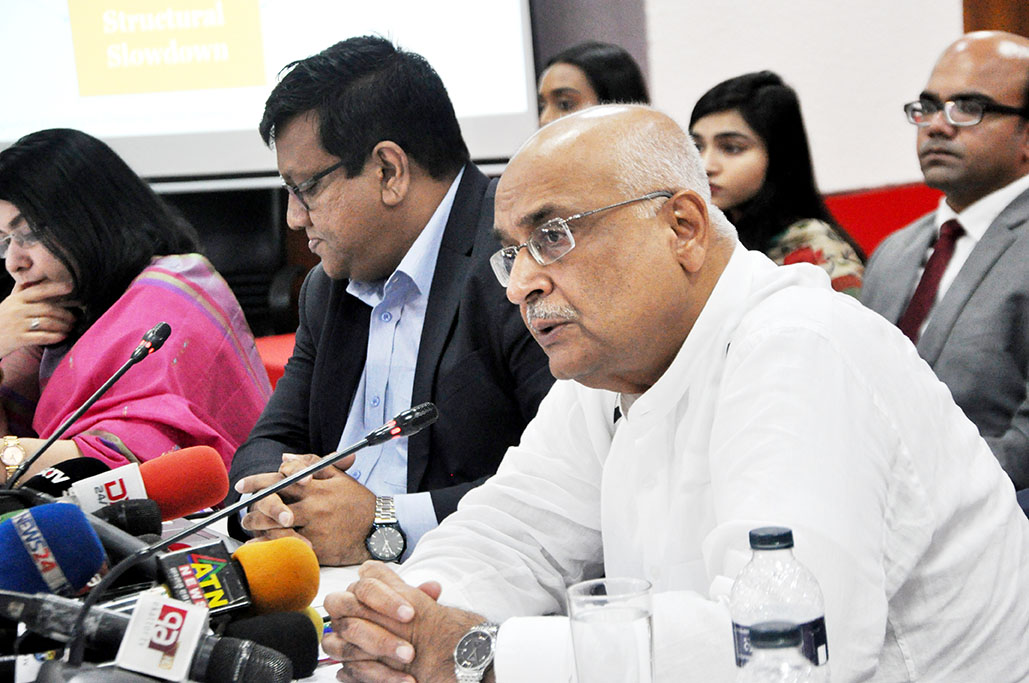
“There is a growing stress in the macroeconomic stability. Overall situation aggravated as very little structural and institutional reforms are undertaken in the economy. This has also diminished the scope to use macroeconomic policy tools.”
These observations have been made by the Centre for Policy Dialogue (CPD) while the Centre undertook an in-depth analysis of four important areas of Bangladesh economy. CPD has raised ‘red flags’ in four areas of Bangladesh economy where immediate attention is required from the policymakers. These areas are revenue mobilisation, banking sector, capital market and external sector. These sectors are suffering from lack of accountability, good governance and adequate regulation. CPD feels that due to the absence of structural and institutional reforms, private investment is not picking up and inclusivity of economic growth is not being ensured. These may lead to structural slowdown of the economy which will undermine the sustainability of economic growth. In such situations medium and long term development vision of the country will be difficult to achieve.

CPD shared these views today, 3 November 2019, during a media briefing titled “State of the Bangladesh Economy in FY2019-20: First Reading”. The event was organised at CIRDAP Auditorium, Dhaka under CPD’s flagship programme Independent Review of Bangladesh’s Development (IRBD).
Dr Fahmida Khatun, Executive Director, Professor Mustafizur Rahman, Distinguished Fellow, Dr Khondaker Golam Moazzem, Research Director, and Mr Towfiqul Islam Khan, Senior Research Fellow, CPD, made presentations on the aforesaid four areas based on early signals regarding the performance of those sectors. Dr Debapriya Bhattacharya, Distinguished Fellow, CPD, responded to questions from the media and made an overall observation on Bangladesh economy.

While presenting the section titled “The Revenue Challenge”, Mr Khan, mentioned that revenue mobilisation of the country could not keep pace with GDP growth. During FY10-14, total revenue increased by 1.2% for 1% growth in GDP, and during FY15-19, total revenue increased by 1.1% for 1% growth in GDP –indicating a fall in elasticity. The government’s reliance on indirect taxes (VAT, SD, export and import duty etc.) for revenue mobilisation creates an added pressure for the low-and middle-income section of the society. Mr Khan told that the increasing trend in revenue shortfall has become a major concern for national economy which results in limiting public services for the citizens. For, example, he presented that the revenue shortfall increased to BDT 87,227 crore in FY19, which is enough to finance almost three more Padma bridges in a single year.
Dr Khatun made her presentation on the state of country’s banking sector titled “Banking Sector: Stuck in a Quagmire of Woes”. The total volume of non-performing loans (NPLs) in the banking sector was BDT 112,430 crores as of June 2019. By terming this amount ‘outrageous’, Dr Khatun, presented a comparative picture of opportunity costs of NPLs such as building various infrastructure projects. She underscored that an overall reform of Bangladesh’s banking sector is urgently needed. The malaise of the country’s banking sector is due to lack of governance and accountability mainly at four levels; these are- Bangladesh Bank, Ministry of Finance, commercial banks, and judicial process. Her presentation also highlighted issues of weak private sector credit growth, liquidity stress, loan rescheduling and write off, cap on interest rate capital inadequacy in certain banks and recapitalization of banks.

The state of Bangladesh’s capital market titled “Capital Market in Crisis” was presented by Dr Moazzem. He has identified five institutional and governance related weaknesses concerning the capital market, such as poor quality initial public offerings (IPOs), anomalies in financial reporting, lack of transparency in beneficiary owner (BO) accounts, suspicious trading in secondary market and questionable role of institutional investors. Market irregularities and malpractices have created scope for ‘siphoning off’ large amount of funds by a section of influential groups. As a result, small investors have been betrayed time and again, and have lost their hard-earned savings by participating in so-called ‘elusive market’.

Professor Rahman presented the situation of the balance of payments. His presentation titled “External Sector Performance: The Gathering Cloud” shows that for the first time since FY11, the overall balance was negative in FY18 [USD (-) 857.0 million]. In FY19 it barely made into the positive terrain [USD (+) 12.0 million]. Bangladesh is falling behind its major competitors in the key market of the USA. Bangladesh’s export growth in the USA over the first two months in FY2020 was 3.1% which is significantly lower than other competitors like Cambodia (8.2%), China (4.9%); Turkey (10.3%) and Vietnam (11.7%). In FY20, allocation for fiscal incentives for export was USD 470 million, with USD 360 million added on for remittance (2% each incentives). As Bangladesh moves towards LDC graduation, such cash incentives may come under closer scrutiny.
While sharing his overall observation on Bangladesh economy, Dr Bhattacharya, stressed on ensuring rule of law in the country’s economy. He questioned Bangladesh’s GDP growth numbers since private investment is stagnant. As the present development effort is solely based on public investment, the issue of reforms in private investment is crucial. This has been overlooked for long which has resulted in high unemployment. The government should focus on achieving an inclusive economy through bringing in adequate institutional and policy reforms, he added.
The briefing was followed by a Q/A session with journalists from print and electronic media.



